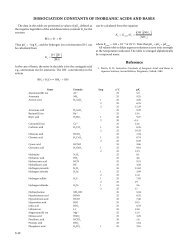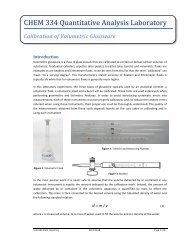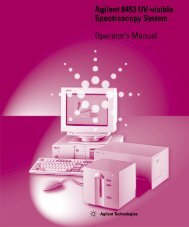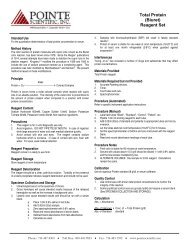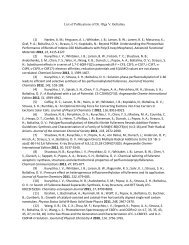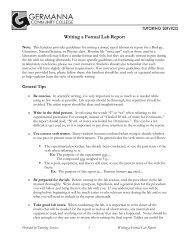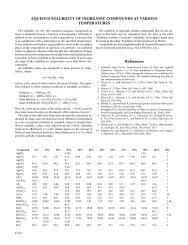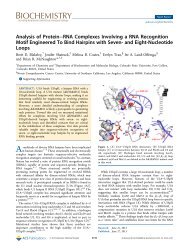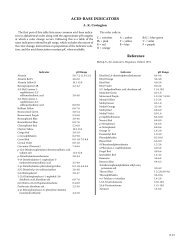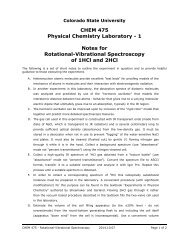CHEM 475 Physical Chemistry Laboratory - 1 Course Syllabus
CHEM 475 Physical Chemistry Laboratory - 1 Course Syllabus
CHEM 475 Physical Chemistry Laboratory - 1 Course Syllabus
You also want an ePaper? Increase the reach of your titles
YUMPU automatically turns print PDFs into web optimized ePapers that Google loves.
<strong>Laboratory</strong> Location: Yates 503Colorado State UniversitySpring Session 2015<strong>CHEM</strong> <strong>475</strong><strong>Physical</strong> <strong>Chemistry</strong> <strong>Laboratory</strong> - 1<strong>Course</strong> <strong>Syllabus</strong>Instructor: Dr. Joseph DiVerdiOffice Location: Yates 504AEmail Address: joseph.diverdi@colostate.eduOffice Phone: 970.980.5868Office Hours: MT 11:00 AM – 12:00 PM, R 3:00 PM – 4:00 PMOffice Hour Location: Yates 502, 503, 504Graduate Teaching Assistant: Scott CompelEmail Address: scott.compel@colostate.eduOffice Hours: R 3:00 PM - 4:00 PMOffice Hour Location: Yates 503Section #: L1 <strong>Laboratory</strong> Hours: T: 3:00 AM - 6:00 PM<strong>Course</strong> Purpose: The objectives of this laboratory course are:(1) To provide the student with practical experience in the techniques of experimental physicalchemistry.(2) To deepen the student's understanding of the principles of spectroscopy, thermodynamics andkinetics through experimentation.(3) To develop more sophisticated chemical laboratory skills in the student.(4) To increase the student's ability to communicate effectively and professionally both in writingand in speech.(5) To develop the student's ability to read, interpret and understand modern professional chemicalliterature.(6) To foster, encourage and develop critical thinking and higher-order creative thinking in thestudent.<strong>Course</strong> Topics: The experimental measurement of thermodynamic properties of matter, theapplication of experimental physical chemistry methods, the development of instrumental methodsand the application of advanced mathematics to problems in physical chemistry.Prerequisites: <strong>CHEM</strong> 334 - Quantitative Analysis <strong>Laboratory</strong>.Textbook: No textbook is required for this laboratory course. Garland et. al. (see below) will be usedas a source for many of the experiments to be carried out in this course. Textbooks that should be onthe bookshelves of professional chemists at this stage in their development:(1) Experiments in <strong>Physical</strong> <strong>Chemistry</strong>, Carl Garland, Joseph Nibler and David Shoemaker, ISBN9780072828429(2) Data Reduction and Error Analysis, Phillip Bevington & D. Keith Robinson, ISBN 9780072472271;(3) An Introduction to Error Analysis, John Taylor, ISBN 9780935702750.Academic Policies & Integrity: The University's policies on Students' Responsibilities and Rightsincluding Personal Integrity, Academic Integrity and related areas are presented athttp://catalog.colostate.edu/, especially as described in Section 1.6 on "Policies and GuidingPrinciples". These policies will be followed in this course. The short of it is compactly contained in theHonor Pledge:<strong>CHEM</strong> <strong>475</strong> <strong>Course</strong> <strong>Syllabus</strong> 2015.01.15 Page 1 of 5
"I will not give, receive or use any unauthorized assistance."Assistance from colleagues, experts and other sources is authorized but a threshold exists abovewhich the assistance must be cited. This will be discussed (at some length) in the laboratory sessions.Additional information on University policies on course registration, add/drop, withdraw andincomplete grades can be found at http://www.catalog.colostate.edu/, especially as described inSection 1.7 on "Advising and Registration". These policies will be followed in this course also.Web-based <strong>Course</strong> Tools: http/:canvas.colostate.edu/. As a registrant of this course, the studentcan access its site and must do so to view announcements, receive grades and submit laboratoryreport and presentation files. Experimental descriptions are available athttp://www.chem.colostate.edu/diverdi/.<strong>Course</strong> Plan & Organization: This laboratory course will be conducted as a "local" course in contrastto a "distance" course. As such, the student is expected to attend each laboratory session frombeginning to end of each session, not arrive late and not plan to leave early. Each student is requiredto submit <strong>Laboratory</strong> Reports individually although the experimental data used in the creation of thesemay be collected as a group.<strong>Laboratory</strong> Notebook: Each student will create and maintain a <strong>Laboratory</strong> Notebook throughout this<strong>Laboratory</strong> course and is required to obtain a bound book for this purpose. It is best used as both ajournal (or laboratory diary, if you will) and a workbook. This <strong>Laboratory</strong> Notebook will be reviewedand a grade applied to it based on the customary requirements for a laboratory notebook.Experimental Protocol & Description: This document describes a particular experiment with a briefand succinct background explanation, experimental description and resulting data analysis description.An instance of this document exists for every experiment that will be performed in this course. All ofthese documents will be available in electronic form on RamCT. Obtain and study each one of thesedocuments prior to arriving at the laboratory for the corresponding experiment. Understand thetheoretical chemistry that you will be applying before you arrive at the laboratory using your personallibrary (you are developing your own library of important chemistry texts, aren't you?) or various webbasedresources (beware of bogus resources - seek out reputable sources and don't accept everythingthat is "published"). You are not required to create hardcopy for this course but you may wish to do sofor your own benefit; there are computers in the laboratory that can be used for viewing thesedocuments (but not for the first time, of course). Do not use the laboratory printer for creatinghardcopy of these documents.<strong>Laboratory</strong> Experiments: There are a number of experiments that can be performed in this course;examples are provided below. Each student will perform four experiments. For some experiments,students will work individually and for others, in groups. Each student will not necessarily performevery experiment. Each experiment will occupy three weeks of laboratory time and a <strong>Laboratory</strong>Report will be submitted individually by each student and for each experiment.<strong>Laboratory</strong> Report: A <strong>Laboratory</strong> Report is the final product of a <strong>Laboratory</strong> Experiment. <strong>Laboratory</strong>Reports will follow the standard Introduction, Materials and Methods, Results, Discussion,Acknowledgements and References (Appendices as needed and outside of the page limit) format foundin professional journals. (Look up the Journal of <strong>Physical</strong> <strong>Chemistry</strong> if you're not already familiar withit.) Each Report will be no more than eight (8) pages in length, with a separate title page and in singlecolumn format. The <strong>Laboratory</strong> Report will be submitted both (1) in hardcopy form and (2)coincidently as a single PDF file (no other format is acceptable and a zero grade will be issued ifeither is not submitted) at the beginning of the laboratory period one week after the correspondingexperiment commenced. No late submissions will be accepted. (Don't Even Ask.) No "re-grades" willbe performed. Plan your work accordingly. Make requests for help to the GTAs and <strong>Laboratory</strong>Instructor in a timely manner. Print your hardcopy version from the PDF version so that they areidentical.<strong>CHEM</strong> <strong>475</strong> <strong>Course</strong> <strong>Syllabus</strong> 2015.01.15 Page 2 of 5
A professional style for the names of files submitted is required. Use lower case exclusively. Use thefollowing format for <strong>Laboratory</strong> Reports and for Oral Presentations submitted in this course,respectively:"<strong>475</strong>_last_name_report_#1.pdf""<strong>475</strong>_last_name_oral_presentation.pdf"Oral Presentation/Examination: Each student will make a formal oral presentation of one of the<strong>Laboratory</strong> Experiments and <strong>Laboratory</strong> Reports and be questioned about it. The choice of theExperiment to be used in the Oral Presentation will be made by the student in consultation with andwith the approval of the <strong>Laboratory</strong> Instructor. A projector and companion computer will be set up in aclassroom for presentations and a laser pointer will be provided. Students will bring theirpresentations on their own USB disks in PDF format only (no other format will be accepted).Students will make a presentation in their regularly scheduled section. Each student will be allocatedfifteen (15) minutes in which to make a presentation and answer questions. The presentation orderwill be reverse alphabetical (using the last name) and all students are expected to be present for allpresentations. Students will be expected to make a serious oral presentation at an upper divisionuniversity level on a topic of chemistry and to demonstrate an understanding of the material byresponding to questions from the audience. Students are strongly advised to review their PDF files andpractice their presentations prior to making them in class where they will be assessed and graded.<strong>Laboratory</strong> Grades: Each student's final course grade will be based on (1) the scores earned on thefour <strong>Laboratory</strong> Reports (each worth 100 points), (2) the score earned on the Oral Presentation (worth100 points) and (3) the score earned on the <strong>Laboratory</strong> Notebook (worth 100 points). The final coursegrade will be based on the number of points earned out of a possible 600 points. The final letter gradeissued will be based on breakpoints set by the <strong>Laboratory</strong> Instructor in the final earned pointdistribution.The Oral Presentation must be made and the slides must be submitted (as a PDF file) coincident withthe delivery of the presentation. Failure to complete both of these tasks at the appointed time willresult in a failing course grade, that is, "F."If a student fails to submit one of the four <strong>Laboratory</strong> Reports, the Oral Presentation score will besubstituted for the missing <strong>Laboratory</strong> Report score as well as being counted as the Oral Presentationscore.If a student submits all four <strong>Laboratory</strong> Reports and the Oral Presentation score is higher than thelowest of the four <strong>Laboratory</strong> Report scores, the Oral Presentation score will be substituted for thelowest of the <strong>Laboratory</strong> Report scores as well as being counted as the Oral Presentation score.No extra credit or alternate grading schemes will be offered or issued. Final course grades will beissued from the following list: A, B, C, D or F. No "plus" or "minus" values for the final course gradewill be issued. There will be no written examinations, including a final examination, in this laboratorycourse.<strong>Laboratory</strong> Experiments: The following is a list of short descriptions of experiments that will beperformed in this laboratory course. The order in which these experiments are performed will varyamong the student groups. The exact schedule will be clearly communicated during the semester.A. Quantum Mechanical Computation - potential energy of diatomic moleculesB. Normal Modes - infrared spectroscopy of halogenated hydrocarbonsC. Rotational-Vibrational Spectroscopy - infrared spectroscopy of hydrogen chloride isomersD. Nanoparticle Growth Kinetics - near ultraviolet spectroscopy of zinc oxide colloidE. Rotational Potential Energy Barrier - NMR examination of a chemically exchanging systemF. Steady-State Fluorescence - fluorescence of aqueous quinine and quenching by halide ions<strong>Laboratory</strong> Safety: The physical safety in the laboratory of all personnel including students, GTAsand faculty is of paramount importance. Proper laboratory dress and conduct are required at all times.Students are required to secure and use their own approved (!) protective eyewear. There are no<strong>CHEM</strong> <strong>475</strong> <strong>Course</strong> <strong>Syllabus</strong> 2015.01.15 Page 3 of 5
"loaners" available in the laboratory. Additionally, students are required to be suitably attired in thelaboratory according to the clearly and previously identified in the lower division laboratory courses atall times. Lastly, professional and courteous conduct is required at all time. Students failing to abideby any of these requirements will be summarily ejected from the laboratory without provision formaking up any experimental work missed and without any special consideration in the evaluation andgrading of the corresponding submitted materials.<strong>Laboratory</strong> Topic Schedule:<strong>Laboratory</strong> ScheduleWeek Beginning Topic Notes19 Jan <strong>Course</strong> IntroductionExperiment #126 Jan Experiment #12 Feb Experiment #19 Feb Experiment #116 Feb Experiment #2 Experiment #1 Report Due23 Feb Experiment #22 Mar Experiment #29 Mar Experiment #3 Experiment #2 Report Due16 Mar University Holiday23 Mar Experiment #330 Mar Experiment #36 Apr Experiment #4 Experiment #3 Report Due13 Apr Experiment #420 Apr Experiment #427 Apr <strong>Laboratory</strong> Check-OutExperiment #4 Report Due<strong>Laboratory</strong> Notebook Evaluation4 May Oral Presentation/Examination Presentation File DueStudent <strong>Course</strong> Survey11 May Final Examination Week No final examinationUniversity Activity Conflicts: Any student having a conflict with this Schedule as the result ofscheduled University Activities is asked to inform the Instructor via e-mail during the first week of thesemester. The options will be reviewed at that time and accommodations will be made, both asprovided for by University Policy. Otherwise, students are expected to be executing according to theSchedule presented in this <strong>Syllabus</strong>.Topics of Great Importance: The following items represent various methods and techniques thatare central to the ways of <strong>Physical</strong> <strong>Chemistry</strong>.1. How to prevent the contamination of solid and liquid reagents and equipment, etc.2. How to properly handle and use a high-pressure gas cylinder.3. How to perform high-quality, well-controlled physical chemistry experiments.4. How to read analog and digital instruments5. How to create high-quality graphs and how to embed them in a document.6. How to create high-quality laboratory reports modeled on high-quality journal articles.7. How to create robust and portable documents and presentations.8. How to wrangle experimental data from some sophisticated scientific instruments.9. How to understand macroscopic chemical systems at a molecular level usingspectroscopic principles, that is, through the skillful use of the interaction ofelectromagnetic radiation and matter.Homework: There is no specifically assigned or named "homework" for this upper-division universitycourse. Your responsibilities outside of the laboratory are: (1) to prepare for each particularexperiment by obtaining the appropriate <strong>Laboratory</strong> Description prior to the time when you will beginthe actual experimental work and (2) to create an upper-division university <strong>Laboratory</strong> Report. Within<strong>CHEM</strong> <strong>475</strong> <strong>Course</strong> <strong>Syllabus</strong> 2015.01.15 Page 4 of 5
these short descriptions you are responsible for seeking out the information necessary for completingthese tasks. As in other upper-division university courses it is considered customary to spend aserious three times the actual contact time on these "homework" activities. Three hours of scheduledlaboratory time each week translates into nine hours of out of laboratory work.<strong>CHEM</strong> <strong>475</strong> <strong>Course</strong> <strong>Syllabus</strong> 2015.01.15 Page 5 of 5



